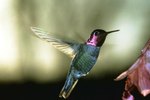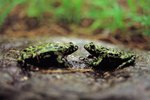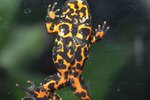
The "ribbit" sounds that many types of frogs often produce is distinctive, but usually not disruptive enough to the point that you ever need to cover your ears with both hands. However, some frogs are just that loud -- namely, the common coqui frog (Eleutherodactylus coqui), which hails from the Caribbean island of Puerto Rico.
Loudest Frog Species
The calling vocalization of the male common coqui frog is certainly a loud one. Due to the strength of these calls, these creatures are not only the noisiest frogs of all, but actually the noisiest out of all amphibians, too, according to National Geographic.
About the Common Coqui Frog
The common coqui frog resides in Puerto Rico, and as a result of introduction, also lives in the southern region of Florida, Louisiana, Hawaii and various other Caribbean islands such as St. Croix and St. Thomas. These small brownish or brownish-gray amphibians generally live in mesic forests, damp mountain forests or wetlands and usually spend their time below tree trunks, stones, foliage or garbage piles. These frogs also frequently live in close proximity to humans. Fully grown female coqui frogs are usually a little bit larger than the males. Common coqui frogs do a lot of climbing up trees. The basic diet of these frogs includes elements such as snails, crickets and spiders.
The Call
The extremely loud common coqui frog call consists of two notes, which the latter one being higher. The repetitive vocalization sounds like the two syllables "co" and "qui." The "co" of the call is geared toward other males and has territorial purpose, while the "qui" functions to lure in females for mating. The vocalization starts at the end of twilight and ceases at dawn. When the nocturnal frogs make these unavoidable calls, they generally are situated on tree trunks, over leaves or on branches.
Invasive Pests
Due to the disruptive quality of the call, common coqui frogs are often seen as invasive pests, according to the Global Invasive Species Database. Sonically, these calls reach almost 100 decibels from a distance of a little over a foot and a half away.
References
- USGS Southeast Ecological Science Center: Common Coqui
- IUCN Red List: Eleutherodactylus coqui
- National Geographic: World's Loudest Animals
- USDA Forest Service: Common Coqui
- Global Invasive Species Database: Eleutherodactylus coqui
- University of Michigan Animal Diversity Web: Eleutherodactylus coqui
- AmphibiaWeb: Eleutherodactylus coqui
- Hawaii Invasive Species: Coqui Frog
Photo Credits
-
Hemera Technologies/Photos.com/Getty Images




